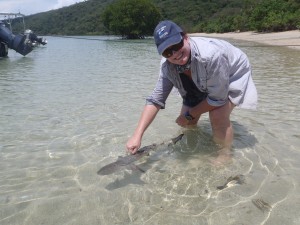NERP TE Project 6.2 - Drivers of juvenile shark biodiversity and abundance in inshore ecosystems of the Great Barrier Reef (JCU)
Project summary
This project is investigating changes in the biodiversity of sharks in inshore nursery areas along the Great Barrier Reef (GBR) coast. The aim is to understand how different factors, such as habitat, season, zoning and environmental parameters, such as discharge from rivers and streams, affect the abundance and diversity of sharks along the central GBR coast.
Why this research is needed
Sharks are facing increasing threats from fishing and other human activities. Inshore areas, which are important nursery areas for sharks, are also popular for fishing and are influenced by freshwater discharge from coastal streams and rivers. If shark populations are going to be sustainably managed into the future, a better understanding of the impact of these pressures on juvenile sharks and critical nursery habitats is required.
Research user focus
Results from the project will be used to improve the information available to fisheries and marine park managers on the relative importance of inshore habitats, the role of areas closed to fishing and the sustainability of inshore shark populations. Research users include the Great Barrier Reef Marine Park Authority (GBRMPA), Queensland Department of Agriculture, Fisheries and Forestry, Queensland Department of Environment and Heritage Protection, and the Queensland Seafood Industry Association.
Outcomes
Outcomes of the project will include reports on:
- The distribution of inshore shark biodiversity along the central GBR coast
- Temporal changes in inshore shark biodiversity along the central GBR coast and the factors that drive these changes
- The effects of environmental factors, such as salinity and temperature, on the movement, distribution and habitat use of juvenile sharks and implications for their conservation and management.
Reports, Publications and News
For more information see Project 6.2 'Drivers of juvenile shark biodiversity and abundance in inshore ecosystems of the Great Barrier Reef' on the NERP Tropical Ecosystems Hub site.
Datasets

This dataset contains the catch data from seasonal gillnet and longline surveys of shark nursery areas in the Central Section of the Great Barrier Reef Marine Park (2011-2014).
Methods:
Sharks play an important role in marine ecosystems but are facing increasing pressure from fishing and other anthropogenic factors. Along the Queensland coast inshore waters play an important role as nursery areas for sharks. However, the same inshore waters are also most prone to fisheries exploitation and effects of freshwater discharge from coastal streams and rivers. This project will examine the importance of different types of inshore habitat (protected bay vs.








